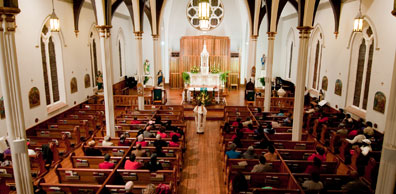
 CHARLESTON—A historical display is open in the lower church of St. Patrick as part of its 175th anniversary celebration, and it weaves the history of two churches and two communities.
CHARLESTON—A historical display is open in the lower church of St. Patrick as part of its 175th anniversary celebration, and it weaves the history of two churches and two communities.
As any of the parishioners will tell you, one can’t relate the history of St. Patrick without also sharing the story of St. Peter. It is a story that resounds with the struggles and divisions of the South.
St. Patrick was formed in the early days of the diocese, and served the whole community, black and white, but on separate sides of the aisle. Racial strife led to the segregation of the two churches shortly after the end of the Civil War.
Thus St. Peter was built, and for almost 100 years it served the spiritual needs of the black community while St. Patrick was home to the white community. Then came the tumultuous era of civil rights protests and federally mandated desegregation.
It was not an edict received graciously by the South, even in regions known for genteel manners and welcoming hospitality.
“Segregation in Charleston was just so stark, and the church reflected that,” said Judge Arthur McFarland, a parishioner of St. Patrick and former parishioner of St. Peter.
He said his family was highly involved in civil rights, and he even volunteered to be one of nine students to desegregate Bishop England High School in 1964.
By the time St. Peter was closed in 1967 as part of the desegregation effort, McFarland had left to attend Notre Dame and then law school, but other parishioners remember the closing.
Doris E. Hazel grew up in St. Peter and said, together with Our Lady of Mercy Church, that they formed a small, intimate community where everyone knew one another.
When parishioners heard that St. Peter was closing, it was traumatic for many, she said. Eventually, she learned it was a good change — the church was beautiful and the children adapted easily. But in the beginning, it was difficult.
Even though the church had officially desegregated its institutions, the people resisted.
Those who decided to attend St. Patrick found that most of the white parishioners were gone. Mrs. Hazel said only a handful remained, but she recalls clearly how warm and welcoming those families were, and said they remained an integral part of the church.
When McFarland returned to Charleston and joined St. Patrick, mostly what he found were the parishioners of St. Peter, just in a different church.
All of the parishioners who talk about this time give praise to Father Egbert Figaro. The first black priest to serve the Charleston area, he is credited with helping rejuvenate the spirit of the parish and making the black community feel like an integral part of the Catholic Church.
Wilfred J. Steplight Sr. and Marjorie Alston Steplight said Father Figaro enlightened them and made them feel like they were part of a rich history.
“He brought some of that African-American culture with him,” McFarland said. Father Figaro introduced the parish to black bishops, other black priests and a lot of changes, such as an emphasis on involving the youth, and an infusion of gospel and spiritual music into Mass.
“When you go to church, you’re looking to have your spirit lifted,” McFarland said. “Father Figaro did that.”
He also guided others to the priesthood, including Father Freddy Washington, who was ordained at St. Patrick and now serves in Chicago. Father Freddy acted as facilitator at the Mission Revival held Feb. 2-5 as part of the 175th anniversary.
Mrs. Steplight said she knew Father Freddy when he was a child, and the parish has maintained close contact with him over the years, along with many other priests who helped guide St. Patrick.
She noted that the sense of community and family that was part of St. Peter was not left behind. And although the congregation has changed over the years, that sense of welcome has remained.
“This is not just a church, it is a place of comfort, peace and warmth,” Mrs. Hazel said.
As they move forward and continue to grow, parishioners said they would like to become even more involved with the community and see the youth step up and take their places in leadership roles.
In the meantime, they are going to take pride in what they have already done.
“It is a tremendous occasion for us to be able to proclaim the word for 175 years,” Mr. Steplight said.
